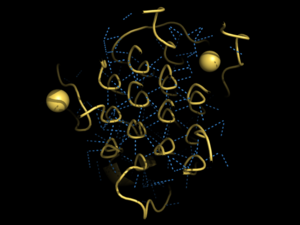Sandbox Reserved 1726
From Proteopedia
(Difference between revisions)
| Line 10: | Line 10: | ||
The <scene name='90/904331/Thb_like_domain/1'>Three Helix Bundle-like Domain</scene> mainly has a structural function overall as it interacts with the tumor necrosis factor-like domain upon ligand binding. | The <scene name='90/904331/Thb_like_domain/1'>Three Helix Bundle-like Domain</scene> mainly has a structural function overall as it interacts with the tumor necrosis factor-like domain upon ligand binding. | ||
==== Poly-Glycine Domain ==== | ==== Poly-Glycine Domain ==== | ||
| - | Located between the three helix bundle-like domain and the tumor necrosis factor-like domain, the <scene name='90/904331/Polyg_region1/1'>Poly-Glycine Region</scene> has an important structural role. The poly-Glycine domain also has a rare and unique structure with hexagonal hydrogen bonding shown in Figure 1. | + | [[Image:Honeycomb.png|300 px|right|thumb|Figure 1. Rare Glycine helices on Anaplastic Lymphoma Kinase]]Located between the three helix bundle-like domain and the tumor necrosis factor-like domain, the <scene name='90/904331/Polyg_region1/1'>Poly-Glycine Region</scene> has an important structural role. The poly-Glycine domain also has a rare and unique structure with hexagonal hydrogen bonding shown in Figure 1. |
==== Tumor Necrosis Factor-like Domain ==== | ==== Tumor Necrosis Factor-like Domain ==== | ||
The <scene name='90/904331/Tnf_like_domain/1'>Tumor Necrosis Factor-like Domain</scene> interacts with the three helix bundle-like domain to begin the conformational changes associated with ligand binding. The three helix bundle-like domain's α-helix interacts with the helix α-1' and β strand A-1'. This domain also assists in mediating ligand binding with the epidermal growth factor-like domain. | The <scene name='90/904331/Tnf_like_domain/1'>Tumor Necrosis Factor-like Domain</scene> interacts with the three helix bundle-like domain to begin the conformational changes associated with ligand binding. The three helix bundle-like domain's α-helix interacts with the helix α-1' and β strand A-1'. This domain also assists in mediating ligand binding with the epidermal growth factor-like domain. | ||
| Line 25: | Line 25: | ||
== Disease == | == Disease == | ||
| - | + | === Cancer === | |
| + | In ALK fusion proteins, the ALK fusion partner may cause dimerization independent of ligand binding, causing oncogenic ALK activation <ref name="Huang" />. | ||
== Relevance == | == Relevance == | ||
Revision as of 20:28, 28 March 2022
| This Sandbox is Reserved from February 28 through September 1, 2022 for use in the course CH462 Biochemistry II taught by R. Jeremy Johnson at the Butler University, Indianapolis, USA. This reservation includes Sandbox Reserved 1700 through Sandbox Reserved 1729. |
To get started:
More help: Help:Editing |
Anaplastic Lymphoma Kinase Extracellular Region
| |||||||||||
References
- ↑ 1.0 1.1 1.2 Huang H. Anaplastic Lymphoma Kinase (ALK) Receptor Tyrosine Kinase: A Catalytic Receptor with Many Faces. Int J Mol Sci. 2018 Nov 2;19(11). pii: ijms19113448. doi: 10.3390/ijms19113448. PMID:30400214 doi:http://dx.doi.org/10.3390/ijms19113448

